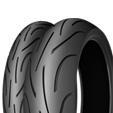From the tip-in point, keep the throttle just open. This maintains the bike in a balanced attitude, with the weight evenly distributed across both wheels.
WHY is this important? Because tyres only have a limited amount of grip, which can used for cornering, OR for braking. To share tyre grip between cornering AND braking, places the tyres at their maximum stress and you may pass their limits of grip. Don’t gripe if grip gives up in this situation – you made it happen.
Also, when leaning over, the rolling radius of the tyres reduces, as the contact patch moves toward the tyre edge. This makes the bike slow down a touch, throwing a little weight forward, so you need to compensate for this by making the engine speed up a little and take that slight extra weight off the front end. You can develop a fine edge of feel for grip and suspension if you do this. You can’t if you don’t.
Tipping in and then backing off the throttle, causes the bike to “dive” on its front-end, applying large forces to the tyre contact
patch.
If the tyre is already fully loaded trying to turn the bike (especially if going in “hot”), then you may exceed the limit and the tyre may slide, particularly if the road surface is damaged, with bumps in the curve or tar waves from trucks braking or turning. Beware the curve in the bottom of a dip. The answer is in balancing the front and rear end tyre loads, smooth throttle, correct road position and of course, an appropriate speed for the vision distance available.

On exit, light up the throttle as much as the grip on the rear and the distance in front allows. (oh yeah, and your license)
This all applies equally to wet weather riding. Same skill set. Its just that the total grip of the tyres is now less than in the dry. Also applies to riding on gravel. In all cases, lumps n bumps must be factored into the corner plan.
A good rider, by using the throttle well, can balance the loads on the their tyre contact patches and can ride across some pretty ugly road surface without a problem, as they are allowing both tyres and suspension to work at their optimum.
Suspension movements are important here. We are not looking at the gross movements and have made an assumption that your bike is correctly adjusted, so it doesn’t dive or squat unduly.



Incorrect suspension adjustment can lead to changes in steering geometry in mid corner, as one end is not balanced with the other. Ths may be a soggy front end leading to the bike oversteering, or a soggy rear causing understeer or reduced cornering clearance (often with a pillion).
If you aren’t sure, seek professional advice.
No, not from the bloke at the pub.
Contact Info
The Motorcycle Council of NSW Inc.
PO Box 517
Parramatta 2124
Ph: 1300 679 622 (1300 NSW MCC)
General Enquiries
Please direct enquiries to:
MCCNSW Email
enquiries@mccofnsw.org.au
Site Menu